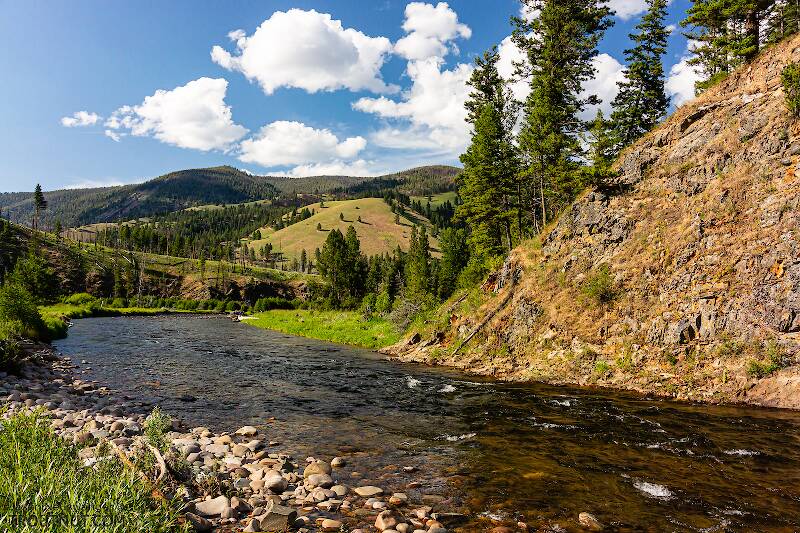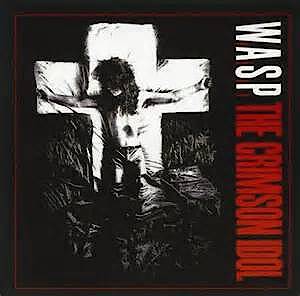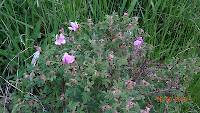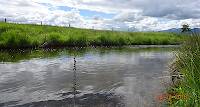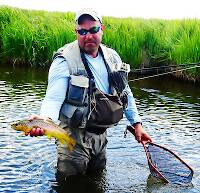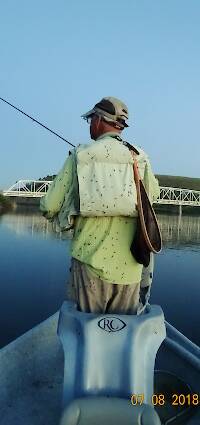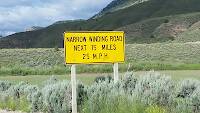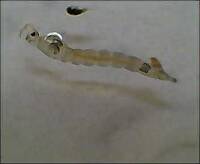
Salmonflies
Pteronarcys californica
The giant Salmonflies of the Western mountains are legendary for their proclivity to elicit consistent dry-fly action and ferocious strikes.
Featured on the forum

It's only barely visible in one of my pictures, but I confirmed under the microscope that this one has a prosternal horn and the antennae are mid-way between the eyes and front of the head capsule.
I'm calling this one Pycnopsyche, but it's a bit perplexing. It seems to key definitively to at least Couplet 8 of the Key to Genera of Limnephilidae Larvae. That narrows it down to three genera, and the case seems wrong for the other two. The case looks right for Pycnopsyche, and it fits one of the key characteristics: "Abdominal sternum II without chloride epithelium and abdominal segment IX with only single seta on each side of dorsal sclerite." However, the characteristic "metanotal sa1 sclerites not fused, although often contiguous" does not seem to fit well. Those sclerites sure look fused to me, although I can make out a thin groove in the touching halves in the anterior half under the microscope. Perhaps this is a regional variation.
The only species of Pycnopsyche documented in Washington state is Pycnopsyche guttifera, and the colors and markings around the head of this specimen seem to match very well a specimen of that species from Massachusetts on Bugguide. So I am placing it in that species for now.
Whatever species this is, I photographed another specimen of seemingly the same species from the same spot a couple months later.
I'm calling this one Pycnopsyche, but it's a bit perplexing. It seems to key definitively to at least Couplet 8 of the Key to Genera of Limnephilidae Larvae. That narrows it down to three genera, and the case seems wrong for the other two. The case looks right for Pycnopsyche, and it fits one of the key characteristics: "Abdominal sternum II without chloride epithelium and abdominal segment IX with only single seta on each side of dorsal sclerite." However, the characteristic "metanotal sa1 sclerites not fused, although often contiguous" does not seem to fit well. Those sclerites sure look fused to me, although I can make out a thin groove in the touching halves in the anterior half under the microscope. Perhaps this is a regional variation.
The only species of Pycnopsyche documented in Washington state is Pycnopsyche guttifera, and the colors and markings around the head of this specimen seem to match very well a specimen of that species from Massachusetts on Bugguide. So I am placing it in that species for now.
Whatever species this is, I photographed another specimen of seemingly the same species from the same spot a couple months later.

Troutnut is a project started in 2003 by salmonid ecologist Jason "Troutnut" Neuswanger to help anglers and
fly tyers unabashedly embrace the entomological side of the sport. Learn more about Troutnut or
support the project for an enhanced experience here.
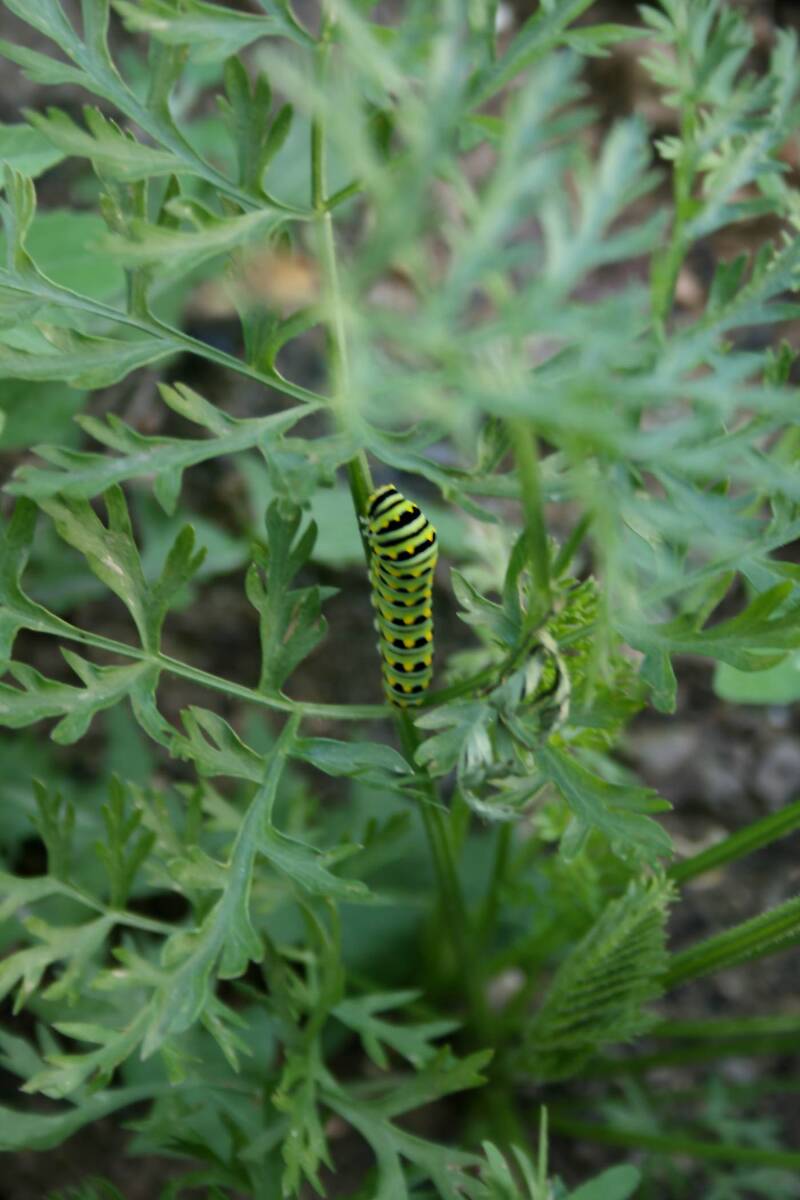
JOHNW on Jul 14, 2011July 14th, 2011, 2:32 pm EDT
I realize these are not the exact perview of this forum however I couldn,t think of a better place to ask with the assembled knowledge which frequents the site.
I photgraphed this caterpillar in the garden eating my carrots this evening. The wife wants to dispatch of it directly since it is eating the greens of one of the very few carrots which are actually growing. To me it vaugely resemblesa monarch and as such I am hesitant to committ insecticide. Can any of the wise "bug guys" provide an identification?
If more info is needed I'll be more than happy to share it.
I photgraphed this caterpillar in the garden eating my carrots this evening. The wife wants to dispatch of it directly since it is eating the greens of one of the very few carrots which are actually growing. To me it vaugely resemblesa monarch and as such I am hesitant to committ insecticide. Can any of the wise "bug guys" provide an identification?
If more info is needed I'll be more than happy to share it.
"old habits are hard to kill once you have gray in your beard" -Old Red Barn
GONZO on Jul 14, 2011July 14th, 2011, 3:51 pm EDT
Hi John,
I believe it is a Black Swallowtail (Papilio polyxenes) caterpillar. The caterpillers are sometimes called Carrot Worms (among other things). They feed on a number of cultivated plants in the carrot family.
I believe it is a Black Swallowtail (Papilio polyxenes) caterpillar. The caterpillers are sometimes called Carrot Worms (among other things). They feed on a number of cultivated plants in the carrot family.
Adirman on Jul 14, 2011July 14th, 2011, 5:02 pm EDT
Sounds very destructive but is also very pretty; too bad!
GONZO on Jul 14, 2011July 14th, 2011, 5:14 pm EDT
Agreed.
JOHNW on Jul 15, 2011July 15th, 2011, 12:01 pm EDT
Hi John,
I believe it is a Black Swallowtail (Papilio polyxenes) caterpillar. The caterpillers are sometimes called Carrot Worms (among other things). They feed on a number of cultivated plants in the carrot family.
Does this mean that my parsnips are in jeopardy?
I don't mind them eating the carrots since of the 300 seeds we planted only 3 came up. Essentially we are writing them off anyway but the parsnips would mean WAR!
"old habits are hard to kill once you have gray in your beard" -Old Red Barn
Jmd123 on Jul 15, 2011July 15th, 2011, 3:10 pm EDT
Go put them on some Queen-Anne's-lace, a.k.a. wild carrot, and they'll be perfectly happy. Same plant family!
Jonathon
Jonathon
No matter how big the one you just caught is, there's always a bigger one out there somewhere...
Quick Reply
Related Discussions
Topic
Replies
Last Reply
9
Jun 16, 2015
by Oldredbarn
by Oldredbarn
2
Apr 7, 2012
by Crepuscular
by Crepuscular

